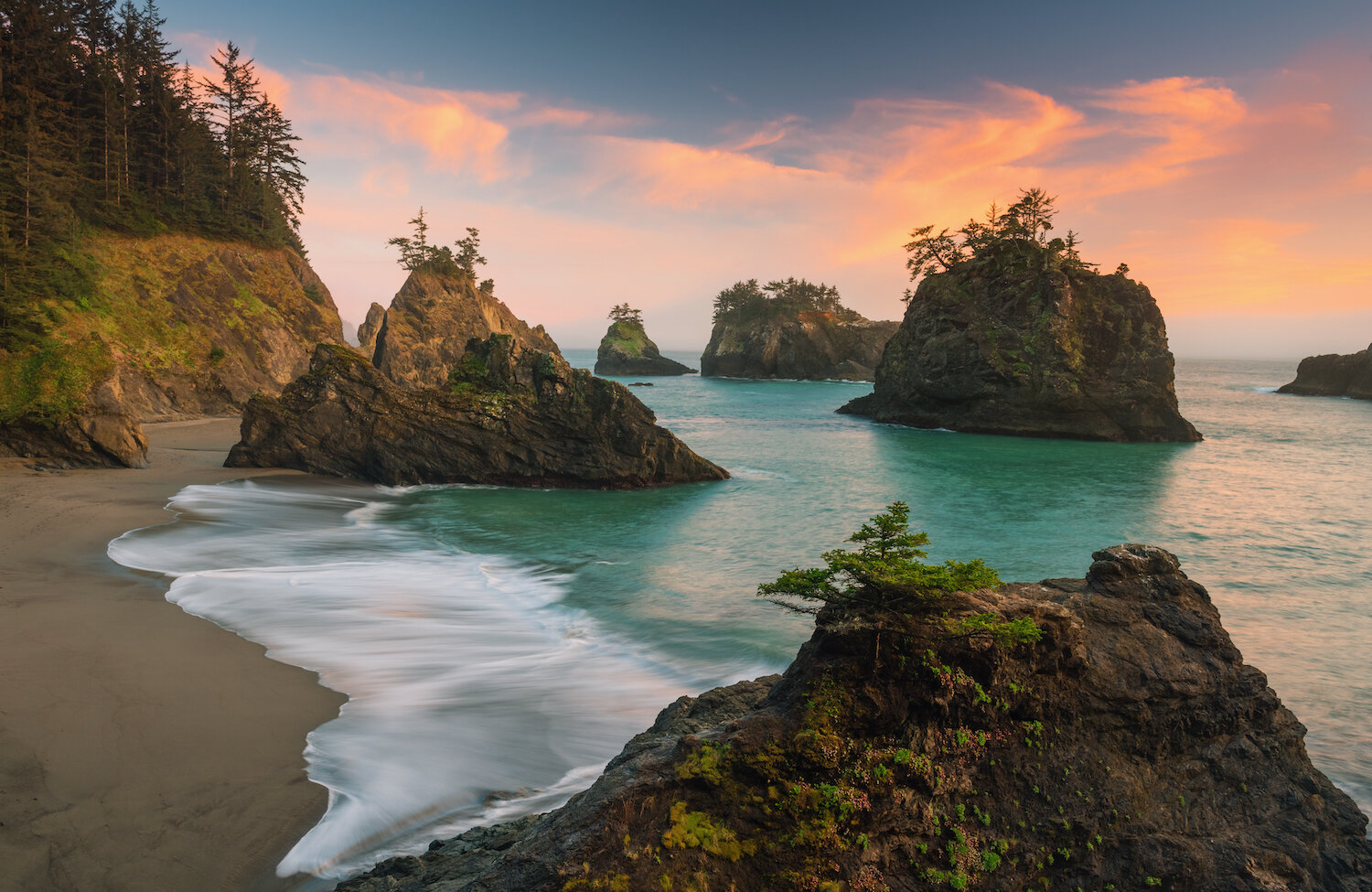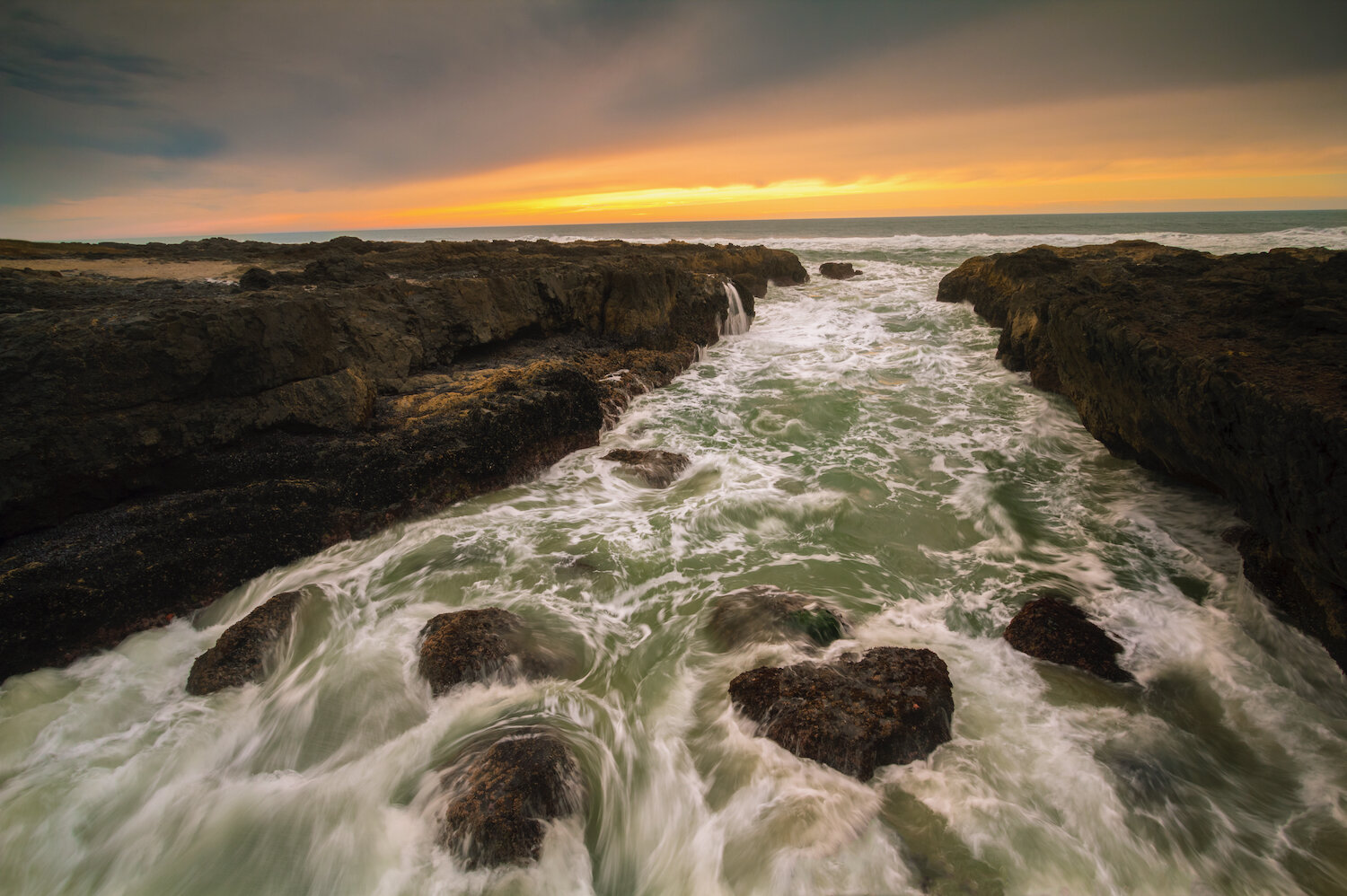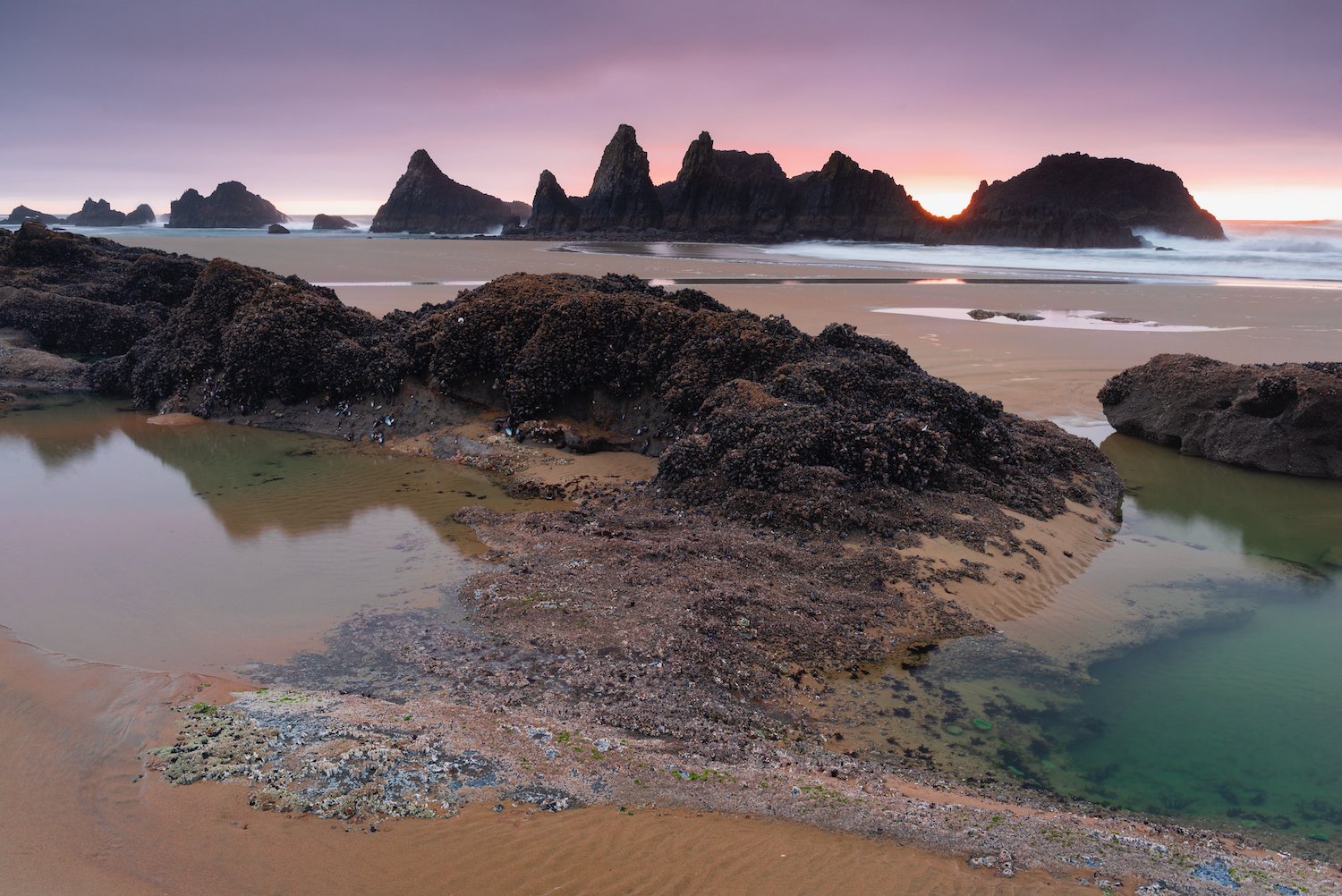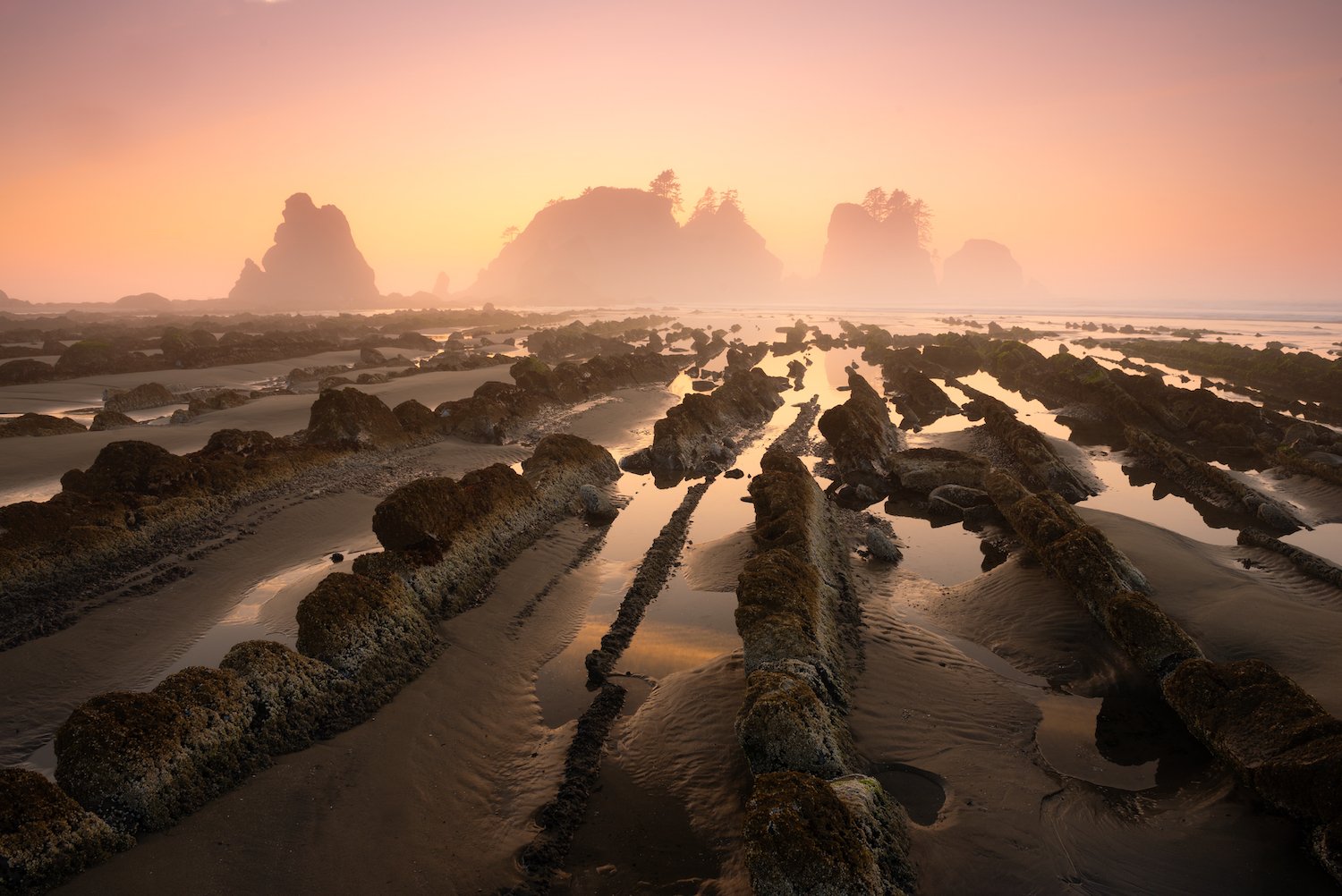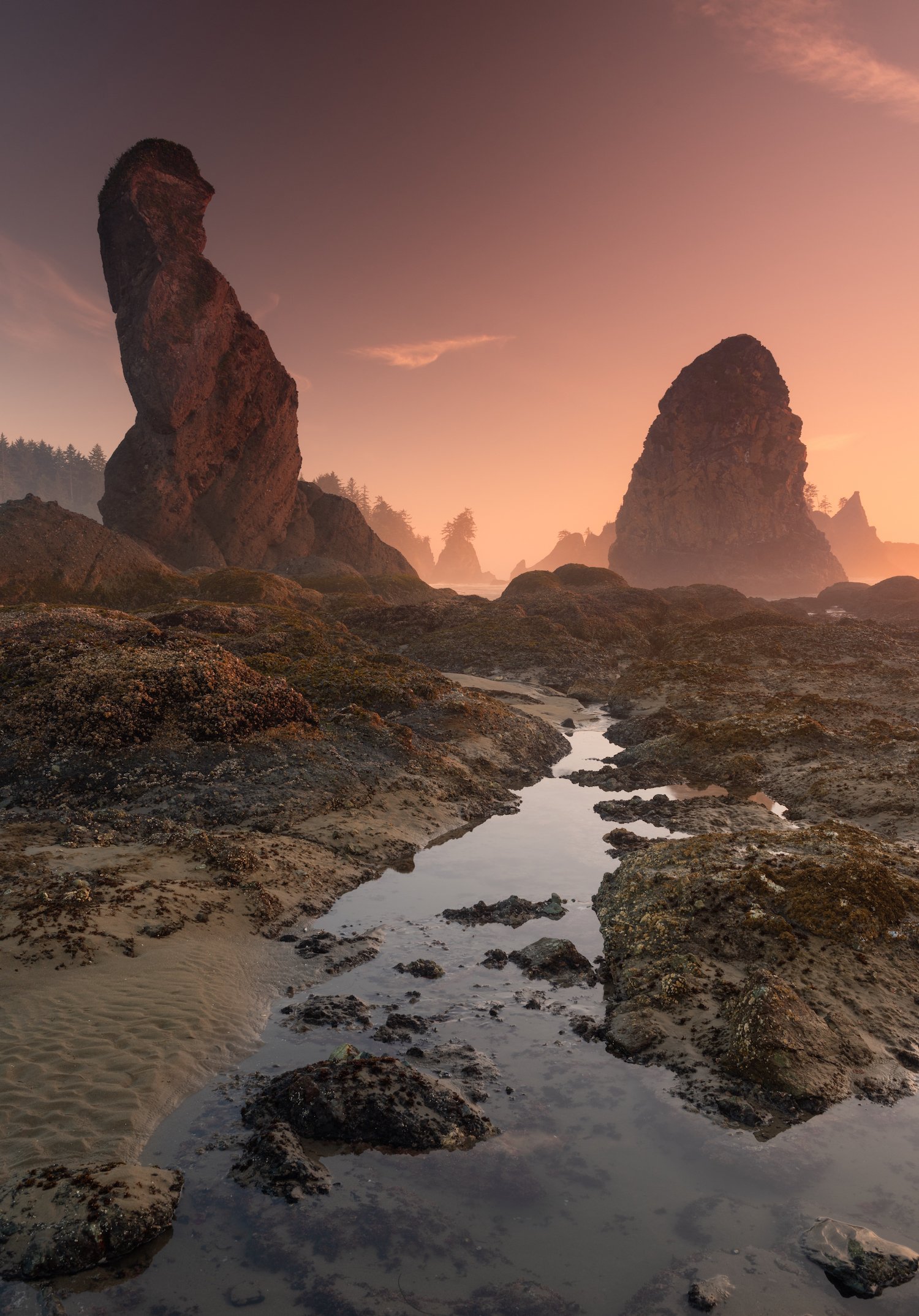Oregon Coast
Bandon beach
While the southern Oregon coast is home to many beautiful sea stack-laden beaches, little compares to the variety found in Bandon Beach. The sheer number of monoliths and formations here is stunning. Photographers are spoiled for choice among the endless compositional variety. Like most beaches, the real beauty reveals itself during low tide when more of the rocks are exposed, including their colorful base.
There are two primary entrances to Bandon Beach: Coquille Point on Kroenberg County Park and further south at Face Rock State Scenic Viewpoint. I found the stacks at the latter to be closer and more diverse but there are so many photographic possibilities on this beach that one can’t go wrong with either.
Samuel H. Boardman State Scenic Corridor
This state park on the far southern portion of Oregon is an absolute gem and favorite for sea stack enthusiasts. The park is 12 miles long and hugs the coastline throughout. It is bisected by a beautiful section of the Oregon Coast Trail, which travels through lush coastal rainforest and opens up to precipitous sections that provide vistas down to the rocks. Because the headlands are so steep and elevated, the sea stacks that survived erosion are large and dramatic.
My favorite section is Secret Beach, pictured here. This sandy oasis is virtually inundated during high tide but when the water recedes visitors can walk up to a few of the many amazing sea stacks right off the coast. The rocks are old enough that small trees and bushes have grown on top of them, a phenomenon common to the Pacific Northwest. Other stunning trails in this area include Natural Bridges and Indian Sands Trails, both highly recommended.
Cape perpetua
Situated west of Eugene, Cape Perpetua is a coastal headland well known for its amazing sitka spruce-dominated old-growth forests, which I document in this guide. However, the coast is incredible as well. Instead of the sea stack-dominated beaches that are profiled in many of the locations in this guide, the beach here is rich with many diverse, unique features. One feature, named “Thor’s Well,” swells with water as the waves flow toward land and it appears to expel that water into the recesses of the earth through a deep cavity. Another feature, named the Sprouting Horn at Cook's Chasm is similarly driven by waves, shooting water into the air as a fountain. A number of narrow ravines flank the area, funneling incoming waves and churning it around before expelling it back out to sea.
seal rock
Seal Rock Recreation Site is located in the heart of the central Oregon coast and home to abundant landscape and wildlife beauty. The most iconic landmark is the massive sea stack, Elephant Rock, a monolith at the north end of the beach that juts out of the sand in imposing fashion. Further south, a smaller wall of sea stacks provides a great photo backdrop due to their multicolored appearance and repeating patterns. The beach is especially magical during low tide when smaller rocks appear and multicolored tidepools reveal pockets teeming with marine life.
Cannon beach
Without question the most famous and visited of all of Oregon’s beaches is Cannon Beach. Owing to its relative proximity to Portland the beach and its quaint coastal towns of Cannon Beach and Seaside, this section of the northern Oregon coast is packed with tourists. It’s also home to the enormous Haystack Rock, an icon of state’s beach system. This 235-foot (72-meter) high sea stack is home to bird colonies and during low tide, visitors can explore the numerous tide pools at its base. These tide pools teem with colorful and diverse sea life, including starfish, barnacles, and sea anemones.
From a photography perspective, Haystack Rock is so large that it’s actually quite difficult to obtain a compelling photograph unless taken from far away. Just south of the monolith are a few distant sea stacks called “The Needles” (pictured here), which I feel are much more photogenic. Smaller and more vertical, these rock formations look like fingers rising from the ocean floor and are well positioned during sunset.
Cape kiwanda
Along with Cannon Beach, Cape Kiwanda is one of the more popular spots for vacationers from around the state. The beach is a bit of a microcosm of the Oregon coast. It has an expansive stretch of sandy shoreline, sea stacks, and large cliffs. There’s something for everyone but for photographers, the best section is in the north around the elevated cliffs. Here, the rocky coast provides many interesting compositions as the waves ebb and flow, moving water around, over, and in between the eroded rocks.
Devil’s punchbowl
Devil’s Punchbowl, one of Oregon’s more recognizable features is a naturally formed bowl that formed when the roof of two sea caves collapsed. The waves and tides have shaped this bowl and the smooth rocks that it houses.
The main viewpoint is from above, where the huge chasm down to the water can easily be seen. More adventurous visitors can hike inside by entering from the beach to the north. Regardless of where one views the punchbowl the formation’s impressive architecture and massive walls are sure to impress.
Washington coast
Shi Shi beach
Judging Washington’s various beaches strictly from a landscape perspective, there is no better spot than Shi Shi. This amazing place is located near the very northwestern portion of the state and requires a four mile hike traveling south to reach its most photogenic section. Indeed at its southern end, numerous sea stacks cluster closely, together named “Point of Arches.” These stacks are particularly diverse in appearance, size, and shape. Best of all, at low tide, a series of eroded rocks reveal themselves in the sand, forming perfect lines that lead to the large, distant islands.
Ruby Beach
The most interesting beaches on the Washington Coast are virtually all located on the westernmost strip of land on the Olympic Peninsula in Olympic National Park. Ruby Beach, located right off Highway 101 in the Kalaloch area of the park, is a great little beach with some sea stacks located near the parking area above the beach. Though it lacks the concentration of sea stacks found in Bandon Beach or Rialto Beach, some of the rock formations here are still quite exceptional and it takes very little hiking or effort see them.
Rialto Beach
Located north of the Quillayute River and south of La Push, Rialto Beach (along with Shi Shi Beach) is one of the best places on the Olympic Peninsula to hike and camp. The walk north along the shore from Mora is littered with numerous secluded campsites behind an impressive collection of giant drift logs.
The hike along the beach represents the very southern portion of the 16-mile Olympic Coast South Trail - one of the premier coastal wilderness hikes found anywhere. Most people stop after 1.5 miles, before a headland that can only be crossed at low tide, to a natural arch called Hole-in-the-Wall. Near this formation in the north, hikers encounter stunning vertical sea stacks that make beautiful subjects during sunset.



